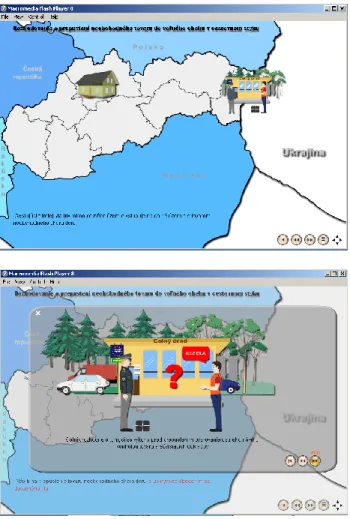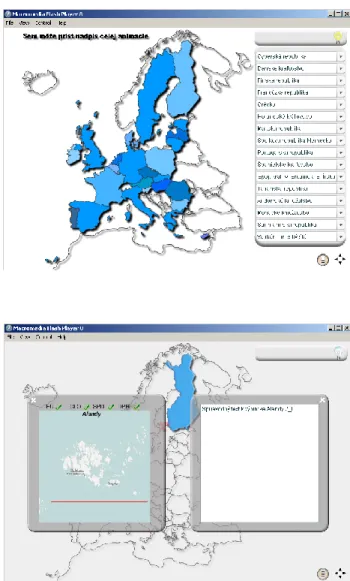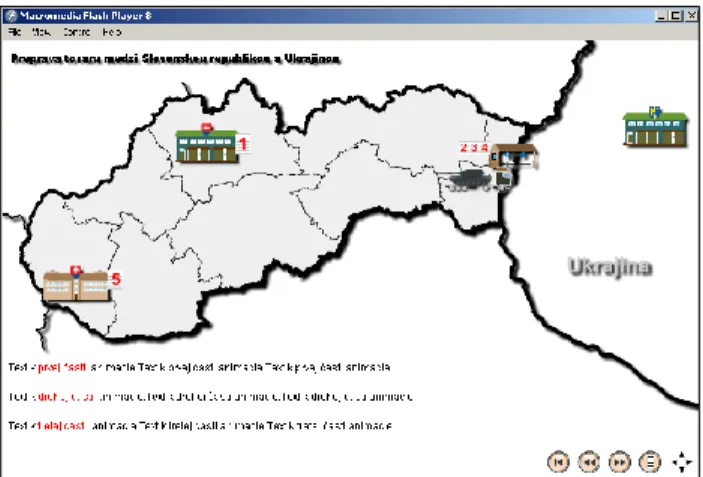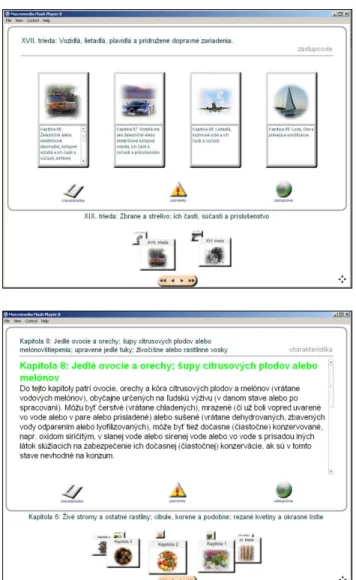Ján Záhorec
Slovak University of Agriculture in Nitra
jan.zahorec@fem.uniag.skJozef Polák – Alena Hašková
Constantine the Philosopher University in Nitra
jpolak@ukf.sk; ahaskova@ukf.skKamil Buranský
SlovDidac Association, Nitra
Kajo13@email.czSUPPORT OF E-LEARNING THROUGH FLASH ANIMATIONS
Introduction
Today in Slovakia, as well as in other countries, a great emphasize is put on further education of employees. These trends are also significantly supported by the European Union. Universities are facing new challenges to find their place in this co-operation with various employer sectors. An example of such co-operation is the project Improving the Professional, Managerial and Linguistic Knowledge and Skills of Customs Officers and Customs Administration (NFP27140130176 – for the target group of the entire territory of the Slovak Republic without Bratislava district, NFP27130330007 – for the target group from Bratislava district region) solution of which is realised with participation of the members of two universities – Constantine the Philosopher Univer- sity in Nitra and Slovak University of Agriculture in Nitra.
Project Description
Improving the Professional, Managerial and Linguistic Knowledge and Skills of Customs Officers and Customs Administration for the Entire Territory of the Slovak Republic is a four-year project (2009 – 2012) implemented with the financial support of the European Social Fund within the Operational Programme Employment and Social Inclusion. Its realisers and co-ordinators are Customs Directorate of the Slovak Republic and SlovDidac Association.
The main objective of the project is to improve the qualification and professional knowledge and skills of the target group and to increase its work effectiveness and quality. The project involves 5 activities.
Three project activities are focused on improving language knowledge and skills for the target group of customs officers working with the European Union agenda, the target group of customs officers working with the Risk Information Form system (an electronic system of direct and safe exchange of information related to customs control) and the target group of customs officers working at the eastern border. Activities cover development of skills in speaking, listening, reading and writing always with respect to
relevant target group and required target level of language skills development according to the Common European Framework of Reference. Concerning the content, activities are focused on:
− vocabulary improvement in a field of finance, tax, legal and customs terminology,
− writing official letters, keeping a written work agenda including writing minutes of meetings and dealing with the official e – mail correspondence,
− prepare presentations and attend performances associated with them,
− arranging phone calls,
− discussions focused on current customs topics,
− improving language knowledge and skills to a level of communication with ordinary tourists, drivers, passengers, etc.
The target groups of the fourth activity are the customs administration seniors and middle management employees. Activity (Development Program for Customs Officers and Employees of the Customs Administration of the Slovak Republic in Management Positions) is focused at developing their skills and abilities in the following areas:
− basic management skills (delegation of tasks and responsibilities, decision- making in difficult situations, formation teams, etc.),
− effective communication and teamwork,
− performance leadership,
− staff motivating and appreciating,
− crisis communication and managing difficult situations,
− negotiation and communication with external partners,
− stress management,
− time management,
− ethics and protocol.
The fifth activity is called E-learning in customs. Its target group is 1,500 customs officers and employees of the Customs Administration. Each of them undergoes retraining at least one of the five areas, namely:
− customs,
− consumptions taxes,
− basic training for the job,
− sampling,
− merchandise.
Implementation of e-learning
Requirement of the project contractor was to implement training of customs officers and Customs Administration employees through the combined form (blended learning).
This requirement is fulfilled in all activities, but the ratio of the traditional face-to-face teaching and e-learning in each of them is different.
Activities focused on improving language knowledge and skills of target groups are structured for specific target groups in the following proportions:
− target group of customs officers working with the EU agenda: 360 hours of the face-to-face teaching in groups with 2 – 6 members + 180 hours of individual learning activities with e-learning support,
− target group of customs officers working in the RIF: 468 hours of the face-to- face teaching in groups with 3 – 7 members + 200 hours of e-learning,
− target group of customs officers working at the eastern border: 180 hours of the face-to-face teaching in groups with 5 – 12 members + 90 hours individual learning activities based on e-learning support.
Within the fourth activity (Development Program for Customs Officers and Employees of the Customs Administration of the Slovak Republic in Management Positions), e- learning is used on the lowest level. The implementation of this activity is mainly based on intensive (training) courses in a total of 96 hours in groups with 7 – 15 participants and subsequent individual consultations and development of individual assignments.
The fifth activity of E-learning is implemented primarily through e-learning.
Participants are divided into 150 groups (according to placement and prior customs training) and work at their own pace, in their own time and space. Presented issues can be consulted through electronic forums, both with each other and also with assigned tutors / consultants.
Use of the flash animations
As mentioned in the above, especially the fifth activity of the described project is realized in the e-learning form. For the purpose of participants retraining in each of five areas, it was necessary to create 23 modules:
− customs area: the Customs Code, the prohibitions and restrictions, the origin of goods, information systems in customs clearance, infringement proceedings, the Common Agricultural Policy;
− tax area: introduction to the excise taxes, a tax ruling (Act no. 511/1992 Coll), excise taxes on electricity, coal and natural gas, excise taxes on beer, wine and tobacco, excise tax on spirit, excise tax on mineral oil, SYSNED information system;
− merchandise area: general rules for the interpretation of the harmonized system, agricultural products, chemical products, leather – wood – paper, textiles, metals, glass – ceramics – precious metals, machinery and equipment;
− sampling;
− introduction to the training for profession.
The modules are mediated to the participants in an environment compatible with the LMS Moodle, respectively compatible in the standard SCROM importable into the LMS Moodle. Because of motivation purposes and a necessity of maintaining attention and activation of learners (users of created electronic courses), animations have been largely used in framing the content of each module. Adobe Flash, which is now standard for creation and distribution of not only teaching presentations but also business and Internet applications or interactive videos, was used for technical construction of animations.
Possibility of easy vector animation of any objects in the scene and applying various effects are strengths of this program. Due to the possibility of streaming, the resulting SWF format of animations guarantees at a small size of exported file a quality and fast
playback of animations in Flash Player which is now automatically a normal part of installation of web clients and operating systems.
In the next section (Fig. 1 to 4 and their corresponding explanations) we present se- lected animations for the sake of explanation and understanding of processed educational content under some of the above-mentioned modules.
Figure 1: Deciding on releasing noncommercial goods for free circulation in the traffic interface
Explanation: Release for free circulation is a customs procedure proposed by a declarant if the imported goods (which are not Community goods) have to be consumed or used in the customs territory so that it can be freely managed as Community goods.
The aim of the animation is to show the operations necessary in Customs Administration for release for free circulation.
Figure 2: Map of the customs territory of the Community with marked exceptions for import and export of goods
Explanation: Map of the customs territory of the Community with marked exceptions for import and export of goods that are subject to value added tax or subject to excise tax is designed as an interactive map. After selection of a territory, this interactive map will show its position towards Slovakia and the EU and by clicking on a given location, details on that territory with their detailed map and also graphic symbols showing classification of the selected area to other customs and tax procedures will be shown.
Figure 3: Method of carriage of military equipment for NATO armies needs
Explanation: The transport of military equipment for the needs of NATO armies shall be based on the customs form FORM 302. The animation shows using the FORM 32 consisting of five letters in different parts of the transport and also shows the procedure for their use.
Figure 4: Practical examples of the tariff classification of goods in the Common Customs Tariff, the sections and chapters
Explanation: Practical examples of the tariff classification of goods in the Common Customs Tariff, the sections and chapters. The classification of goods in the Common Tariff is common basis for the amounts of duty and all other tariff and non-tariff measures applicable to imports and exports of goods from third countries from the perspective of the European Communities. Animations are logically divided into the types of goods that are specifically classified. Animation is used to illustrate a simplified summary of the diversity of classified materials in their own specific sections and chapters.



